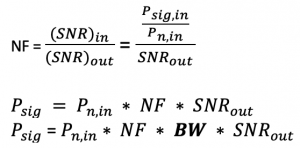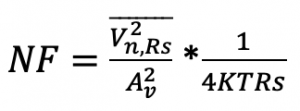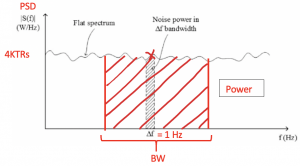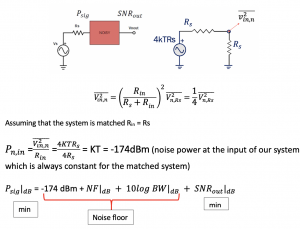
What is Sensitivity in Radio Frequency
What is Radio Sensitivity?
Sensitivity is the minimum signal which can be detected with accepted output SNR (Signal to Noise Ratio).
Accepted output SNR is sometimes called as the minimum output SNR (SNRo, min). It means we are not allowed to have SNR less than this value at the output of our system and if it is less, then the signal won’t be detected. The noise will be dominant, and hence the system will not be working.
Who defines the minimum SNR (SNRmin)?
The characteristics of the application define the specific value of SNRmin, and it is constant for the kind of application. So it can be said as the minimum output SNR for a particular kind of application depending on the system that we can work with, and we can’t decrease the SNR less than this specific value. Therefore, according to this SNR value, we will have the input power at the input of our system called Psignal, which is the input power. There is a specific power value for a system, and this specific power value is called Psensitivity, which is the power of sensitivity. So we are not allowed to reduce the power less than this specific value, and this value is known as the minimum acceptable power for the system. If the power is less than this value, the signal cannot be detected as the signal will become comparable to noise.
The characteristics of the application define the specific value of SNRmin, and it is constant for the kind of application. So it can be said as the minimum output SNR for a particular kind of application depending on the system that we can work with, and we can’t decrease the SNR less than this specific value. Therefore, according to this SNR value, we will have the input power at the input of our system called Psignal, which is the input power. There is a specific power value for a system, and this specific power value is called Psensitivity, which is the power of sensitivity. So we are not allowed to reduce the power less than this specific value, and this value is known as the minimum acceptable power for the system. If the power is less than this value, the signal cannot be detected as the signal will become comparable to noise.
Signal to Noise Ratio (SNR) equals P signal over P noise, therefore having a really low SNR than the SNRmin value means that the power of noise will be higher than the power of the signal. As a result, the power of noise will become dominant, and hence we won’t be able to detect our power of the signal bit as it would be buried within the power and is not detectable anymore.
Finding the minimum acceptable power for the system
The noise figure is defined as the ratio of SNR input over SNR output which can be further written as:
A very important point to remember is the NF defined here is for one Hertz bandwidth (BW). So the definition of Noise Figure in terms of Power Spectral Density (PSD) is:
Read about Power Spectral Density (PSD)
The Power Spectral Density (PSD) of a signal describes the power present in a signal as a function of per unit frequency. For example, PSD always represents power in 1 Hz; when we want to find the PSD of a system, for instance, at a point shown in the diagram below, we always find the power at one Hertz. But now, in our case, as you see here, we have a system with a bandwidth this is called spot noise figure, so we are not finding the NF at only one point but for a bandwidth. So now we’re going to find the power for our system, the power of noise, including the bandwidth.
Imagine the below diagram where 4KTRs is the PSD of input resistance, so when we say 4KTRs, we find PSD for this specific point when delta F is 1 Hertz. But not if you want to analyse the power of the system; we have to find the power of NF for the whole system.

To analyse the system’s power, we have to find the power of the noise figure for the whole system. The above figure shows the bandwidth of our system; as you can see here, power is the area under PSD. The equation indicates that PSD is our average power, so when we are talking about power here, whether its power of signal or the power of noise, we know that our application has the channel, and we have to find the noise in the channel not the noise at one point. In order to find the noise in the channel, we have to multiply the noise figure by its bandwidth. So to find the power related to noise, figure bandwidth is multiplied by PSD.
But we have to make an assumption here as this is only true when the PSD is flat. For our system, we have flat responses all the time. As we know, the NF in terms of PSD, Vn2out is always flat as it comes from the thermal noise of elements inside the noisy system. In order to find the noise figure in the whole channel, we have to multiply this channel by the bandwidth. Re-writing the equation in terms of dBm domain, we get:

How to find input power (Pn, in)?
Now we need to find the input powerFor our system:
The noise floor for our system is always constant because all the three parameters shown in the equation are constant. The noise figure constant and is already defined for our system and we have the bandwidth defined for our system. The minimum SNR out is the minimum or the accepted SNR for our system and knowing this value, we can find the minimum input power.
Now we can find the P signal at the input, and it’s the minimum or is equal to P sensitivity. So this value we get from the equation is the sensitivity of our system. We can’t decrease the input power less than this value, and if we do decrease, then the signal won’t be detected.

The above-shown figure explains the sensitivity concept accurately. The orange one here is our constant noise floor. The signal’s power at the input is above this noise figure; when we add SNRout to the noise figure, we see Psig (min). So this is the minimum input signal we are allowed to put at the input of our receiver. Input power less than this will not be detected.
Example Question to calculate minimum acceptable signal power:
If GSM receiver has SNRout (min) = 12dB, channel bandwidth of 200 KHz and Noise Figure is 9dB. What is the minimum acceptable signal power?
Solution:
The minimum acceptable signal power is -100dBm. As seen in the diagram decreasing the SNRout(min) will also decrease Psig(min). If we drop the minimum input power signal below this value, we won’t be able to detect the signal.




